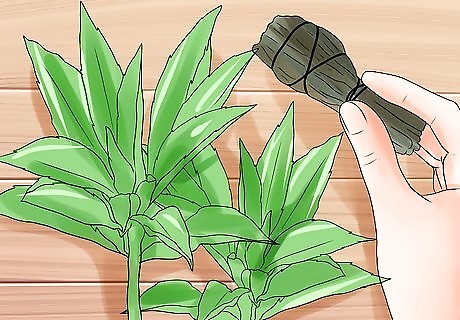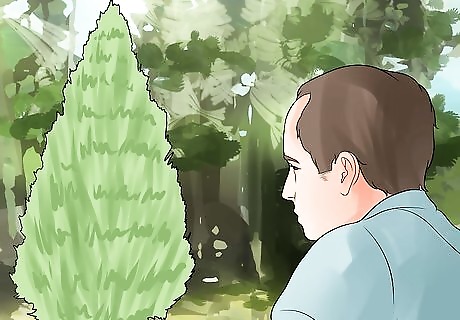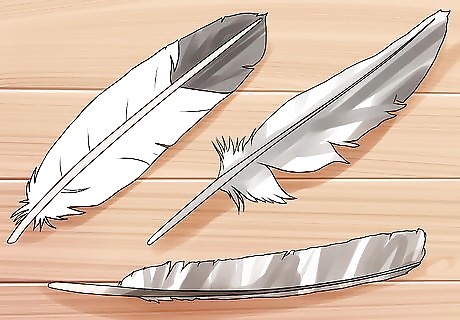
views
Selecting and Gathering Ingredients

Use sage if you are not following a specific tradition. Dozens of Native American tribes and other cultures have their own smudging ceremonies, and each one has its own traditions concerning which plants to use. Sage is probably the most common choice, and is especially important for the Cheyenne and other Great Plains cultures. While many cultures consider white sage to be excellent at driving away bad spirits or energies, other varieties are commonly used as well.

Consider cedar instead if it grows in your area. Cedar is another plant often burned in cleansing ceremonies, especially in the Pacific Northwest or Canada. Note that some trees referred to as "cedars" are actually juniper trees, which some tribes use in smudging and some do not. While many people now mix multiple herbs together, the practice is not supported by some Native American elders. Again, there are many different smudging ceremonies, and some of them may call for sweetgrass or a different plant instead of sage or cedar. Follow this advice to perform an effective and respectful ceremony if you have not been taught a specific culture's tradition.

Only burn sweetgrass after the smudging ceremony is done. Sweetgrass, or holy grass, is a sacred plant across North America, and is often considered to represent kindness and please spirits. It is sometimes burned after the sage or cedar have cleared away negative energy. If you have been taught a specific tribe's tradition that uses sweetgrass in the main ceremony, feel free to use it, or any other plant that tribe allows.

Buy raw, natural tobacco if you want to harvest the plants yourself. While tobacco can be added to the smudging ceremony, stick to one herb if this is your first time smudging. Instead, use tobacco as an offering before you harvest a different herb. See below for more information.

Obtain these plants from respectful sources. If you can, harvest these plants yourself as described in the sub-steps, preferably in as natural an environment as possible. Otherwise, obtain them from a Native American shop in person or online, to ensure the plants were treated appropriately. Before picking the plant, many tribes thank the Creator or nature, then place or burn natural, raw tobacco as an offering. Harvest the correct part of the cedar tree. Pick branches at eye level with green tips. Dry them and crush them into a rough powder before burning. You should not harvest sweetgrass yourself, as it is endangered in some areas. Sweetgrass is usually dried and braided before use, so try to find sustainably harvested sweetgrass braids from a Native American shop or online store.

Choose a natural container to hold it in, or bundle the herb into a bunch. Clay or stone bowls are commonly used in smudging rituals. Abalone shells are another common container, but be aware that some Pacific Northwest tribes believe they are not appropriate for this ritual. Bundles of herbs, called "smudge sticks", can be made yourself or purchased pre-bundled. Some Native American elders question how traditional smudge sticks are, but they are now used even by many Native Americans.

Waft the smoke with a turkey feather (optional). Many people use a feather or fan of feathers to waft the smoke during a smudging ceremony. In the US, eagle and hawk feathers are illegal to possess unless you belong to certain native tribes. Turkey feathers are legal, and traditionally used by some tribes in eastern North America. Do not use owl feathers, as these have different ritual purposes. It is illegal to buy wild feathers in the United States. Purchase cruelty-free feathers from farm-raised birds, or use feathers you've obtained yourself from hunting or finding them in the wild.

Store the materials above waist height and let them dry. Keep your plants and smudging container on a space cleared for them, above the ground. A high bookshelf cleared for their use is a good choice. Do not use the herbs until they are dry, or you will fail to produce the right kind of smoke.

Know when to smudge. Many people smudge when they move into a new place or stay in a hotel room, to purify the new space. You may wish to perform a smudging ceremony after you hear bad news, or when you are preparing for a big change in your life. Smudging could also help you deal with the aftereffects of a big argument or a long illness. Smudging is performed more frequently under certain circumstances, such as in places where other ceremonies take place, or sometimes during archaeological excavations of native remains and sacred materials. Smudging a dorm room may be against university policy against fire use, although some U.S. institutions have changed these policies after challenges based on the First Amendment and freedom of religion.
Smudging a Room or House

Remove metal objects before beginning. Different cultures have different rules for how to participate in smudging ceremonies, but removing metal jewelry, belts, and so forth is a common requirement. This may be considered a way to make yourself spiritually prepared, or can symbolize detachment from valuable possessions. Many experienced ceremony leaders allow you to keep on wedding rings and other metal objects with spiritual significance, so feel free to do so when performing your own ceremony.

Consider following additional rules out of respect. Different traditions have different ways to prepare their participants, but a couple of the more common ones are listed below. Many elders are not strict about these rules, but consider following them out of respect: Do not drink alcohol or take drugs for at least 24 hours before the ceremony, and preferably not for several days. They may leave you spiritually weakened. Menstruating or pregnant people are sometimes asked to leave due to beliefs of their spiritual intensity disrupting the ceremony or leaving them vulnerable. Often, they are welcome at the house smudging ceremony but are not personally purified.

Pray or give thanks. You and anyone else present should enter the ceremony with good intentions. Pray to the world's creator, to spirits, or in whatever way you feel comfortable. If you do not wish to pray, talk or think about your gratitude toward the plants and the earth that produces them. You may continue to pray throughout the ceremony, either silently or aloud. Many people believe the smoke carries your prayers.

Place the dried herbs in the container or bundle them together. You may already have a prepared "smudge stick", or bundle of herbs which can be used for multiple ceremonies. Otherwise, place a small handful of the dried plant material into a natural container, such as a clay, stone, or abalone shell bowl.

Burn the herbs to produce smoke, not fire. You can light the plants with any source of fire, although some people feel more in touch with the ceremony if they use matches rather than a lighter or torch. Let the fire catch hold for about 30 seconds, then blow it out so the herbs are only producing smoke. Feel free to relight the herbs or add more during the ceremony if the smoke starts running out.

Purify each participant by fanning the smoke over their body. Typically, each participant is smudged before the house is. There is no one correct way to perform this part of the ceremony, although one suggestion is described below. Just make sure each participant rubs the smoke against their body and focuses on their ritual purification. If you have an eagle, hawk, or turkey feather, use it to fan the smoke. When you are being purified, use your hands as a cup to catch the smoke, then pass it over yourself or rub it against your skin. In some areas, people put their hands palms downward when they're finished. Many people prefer to start with the head and heart, then move the smoke downward across their arms and legs. You may use any method you wish, however. Menstruating and pregnant people usually do not participate in this part of the ceremony, as they are already in a special spiritual state. Anyone else has the option to politely decline as well.

Walk around the perimeter of the house or room, wafting the smoke to each corner and outside. Use a feather to push the smoke to each place in the house, or use your hands. As you pass by an open door or window, you may use the feather to push the smoke outside, carrying with it the negative energies. Different traditions begin at the east wall, west wall, or front entrance. You may walk clockwise or counterclockwise. As with many aspects of the smudging ceremony, different cultures or individuals follow different practices.

Repeat with one or more additional plants (optional). Some people prepare a new smudging container and burn an additional plant for another effect. Probably the most common of these multi-part ceremonies involves sage and/or cedar for the initial purification, then sweetgrass to please the new spirits or create a positive environment.

Let the ashes cool, then return them to the earth. Thank the earth for providing a sacrifice of plants for you to use, and thank the plants and fire as well. Ashes will provide nutrients back to the soil. This act has a different interpretation in some traditions: the Anishinaabe place the ashes outside to symbolize leaving negative feelings outside the door. You can either let the herbs finish smoldering, or extinguish the plant and return what's left along with the ashes. If using a smudge stick, extinguish it by gently stubbing it against a hard surface. Return the ash and broken fragments to the soil, and store the stick in a special location off the ground for later use.
















Comments
0 comment